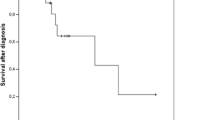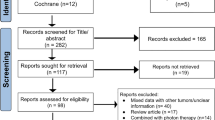Abstract
Skull base chordomas are a rare neoplasm arising from the notochord. Although histologically benign, these tumors are locally aggressive and present significant management challenges. The current series describes the experience at the University of Virginia with Gamma Knife surgery (GKS) in the treatment of chordomas. Fifteen patients (8 males and 7 females) had undergone GKS between 1990 and 2007. The median age was 46 years (range 13–80). The most common presenting symptom was visual disturbance, found in 73%. Twelve patients had undergone tumor resection. Mean tumor volume at the time of GKS was 5.8 cm3 (range 1.03–15.6 cm3). Mean prescription dose was 12.7 Gy (range 12–20) and mean maximal dose was 36.7 Gy (range 28–50). Imaging follow-up was available for all patients with a median time of 88 months (range 8–167 months), and clinical follow-up was available for 11 patients with a median of 70 months (range 8–132). Three patients underwent a second Gamma Knife surgery to treat out of field progression. A Kaplan–Meier plot showed 5 and 10 year actuarial tumor control rates of 50.3% including those undergoing repeat GKS. Symptomatic progression was seen in 75% of the patients. No statistically significant predictive variables among margin dose, maximal dose, tumor volume, number of isocenters, age, and gender were found. GKS affords a reasonable rate of local tumor control in patients with recurrent or residual chordomas. However further long-term follow-up would be necessary to exclude the possibility of late recurrences.



Similar content being viewed by others
References
McMaster ML, Goldstein AM, Bromley CM et al (2001) Chordoma: incidence and survival patterns in the United States, 1973–1995. Cancer Causes Control 12:1–11. doi:10.1023/A:1008947301735
Noel G, Habrand JL, Jauffret E et al (2003) Radiation therapy for chordoma and chondrosarcoma of the skull base and the cervical spine. Strahlenther Onkol 179:241–248. doi:10.1007/s00066-003-1065-5
Chugh R, Tawbi H, Lucas DR et al (2007) Chordoma: the nonsarcoma primary brain tumor. Oncologist 12:1344–1350. doi:10.1634/theoncologist.12-11-1344
Rich TA, Schiller A, Suit HD et al (1985) Clinical and pathologic review of 48 cases of chordoma. Cancer 56:182–187. doi:10.1002/1097-0142(19850701)56:1<182::AID-CNCR2820560131>3.0.CO;2-J
Catton C, O’Sullivan B, Bell R et al (1996) Chordoma: long-term follow-up after radical photon irradiation. Radiother Oncol 41:67–72
Fagundes MA, Hug EB, Liebsch NJ et al (1995) Radiation therapy for chordomas of the base of the skull and cervical spine: patterns of failure and outcome after relapse. Int J Radiat Oncol Biol Phys 33:579–584. doi:10.1016/0360-3016(95)02014-3
Santoni R, Liebsch N, Finkelstein DM et al (1998) Temporal lobe (TL) damage following surgery and high-dose photon and proton irradiation in 96 patients affected by chordomas and chodrosarcomas of the base of the skull. Int J Radiat Oncol Biol Phys 41:59–68. doi:10.1016/S0360-3016(98)00031-5
Muthukumar N, Kondziolka D, Lunsford LD et al (1998) Stereotactic radiosurgery for chordoma and condrosarcoma: further experiences. Int J Radiat Oncol Biol Phys 41:387–392. doi:10.1016/S0360-3016(98)00051-0
Martin JJ, Niranjan A, Kondziolka D et al (2007) Radiosurgery for chordomas and chondrosarcomas of the skull base. J Neurosurg 107:758–764. doi:10.3171/JNS-07/10/0758
Krishnan S, Foote RL, Brown PD et al (2005) Radiosurgery for cranial base chordomas and chondrosarcomas. Neurosurgery 56:777–784. doi:10.1227/01.NEU.0000156789.10394.F5
Pamir MN, Kilic T, Ture U et al (2004) Multimodality management of 26 skull-base chordomas with 4-year mean follow-up: experience at a single institution. Acta Neurochir (Wien) 146:343. doi:10.1007/s00701-004-0218-3
Hasegawa T, Ishii D, Kida Y et al (2007) Gamma Knife surgery for skull base chordomas and chondrosarcomas. J Neurosurg 107:752–757. doi:10.3171/JNS-07/10/0752
Feigl GC, Bundschuh O, Gharabaghi A et al (2005) Evaluation of a new concept for the management of skull base chordomas and chondrosarcomas. J Neurosurg 102(Suppl):165–170
Colli BO, Al-Mefty O (2001) Chordomas of the skull base: follow-up review and prognostic factors. Neurosurg Focus 10:1–11. doi:10.3171/foc.2001.10.3.2
Samii A, Gerganov VM, Herold C et al (2007) Chordomas of the skull base: surgical management and outcome. J Neurosurg 107:319–324. doi:10.3171/JNS-07/08/0319
Samii M, Gerganov VM (2008) Surgery of extra-axial tumors of the cerebral base. Neurosurgery 62(Suppl 3):1153–1169
Sheehan JP, Niranjan A, Sheehan JM et al (2005) Stereotactic radiosurgery for pituitary adenomas: an intermediate review of its safety, efficacy, and role in the neurosurgical treatment armamentarium. J Neurosurg 102:678–691
Snell JW, Sheehan J, Stroila M et al (2006) Assessment of imaging studies used with radiosurgery: a volumetric algorithm and an estimation of its error. Technical note. J Neurosurg 104:157–162. doi:10.3171/jns.2006.104.1.157
Gay E, Sekhar L, Rubenstein E et al (1995) Chordomas and chondrosarcomas of the cranial base: results and follow-up of 60 patients. Neurosurgery 36:887–897. doi:10.1097/00006123-199505000-00001
Tamaki N, Nagashima T, Ehara K et al (2001) Surgical approaches and strategies for skull base chordomas. Neurosurg Focus 10:1–7. doi:10.3171/foc.2001.10.3.10
Al-Mefty O, Borba LA (1997) Skull base chordomas: a management challenge. J Neurosurg 86:182–189
Igaki H, Tokuuye K, Okumura T et al (2004) Clinical results of proton beam therapy for skull base chordoma. Int J Radiat Oncol Biol Phys 60:1120–1126. doi:10.1016/j.ijrobp.2004.05.064
Hug E, Loredo LN, Slater JD et al (1999) Proton radiation therapy for chordomas and chondrosarcomas of the skull base. J Neurosurg 91:432–439
Cho YH, Kim JH, Khang KS et al (2008) Chordomas and chondrosarcomas of the skull base: comparative analysis of clinical results in 30 patients. Neurosurg Rev 31:35–43. doi:10.1007/s10143-007-0099-z
Acknowledgements
The authors wish to acknowledge Dr. Ladislau Steiner and Dr. Dheerendra Prasad who have treated some of the patients included in this study.
Author information
Authors and Affiliations
Corresponding author
Rights and permissions
About this article
Cite this article
Dassoulas, K., Schlesinger, D., Yen, C.P. et al. The role of Gamma Knife surgery in the treatment of skull base chordomas. J Neurooncol 94, 243–248 (2009). https://doi.org/10.1007/s11060-009-9846-z
Received:
Accepted:
Published:
Issue Date:
DOI: https://doi.org/10.1007/s11060-009-9846-z




